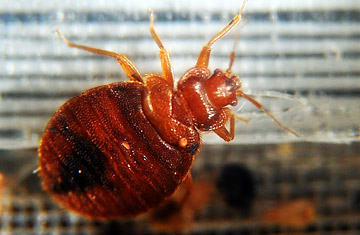
It's not every day you recommend a book that made your skin crawl. But The Bed Bug Survival Guide is a must-read for those who are worried about the growing bedbug infestation. (And honestly, who isn't?) The author, Jeff Eisenberg, is the CEO of Pest Away Inc., a New York City–based company that is championing the fight against the wingless, odorous, red-bodied, bloodsucking Cimex lectularius. When TIME senior reporter Andrea Sachs reached Eisenberg at his office, he alerted her that the bedbug problem is expected to become even worse this summer.
If you spot an insect, how can you tell it's a bedbug?
People get bites for months and never see them, because they're very small. Bedbugs go through five stages before they become adults, and in the first three or four stages you will not see them with the naked eye. Now, on top of that, even the ones you can see, they spend 99% of their time in cracks and crevices. They only come out for three to five minutes at a time to feed on you every seven to 14 days. And they come out, usually, between 2 and 5 o'clock in the morning. So people are literally going crazy waking themselves up each night every 20 minutes, trying to see if they can spot one in the act.
How widespread is the problem?
It's clearly international. [American] cities that had no reported problems, or almost no problems, even four or five years ago, like Philadelphia, today it's gangbusters. People thought it was just a city problem, an urban situation, but it's so not true. The suburbs are probably the fastest-growing population of bedbug problems today, more than even the cities.
Why is the epidemic escalating?
For nine years when I was ringing the alarm bells, saying, "We've got to do something, this problem is real," nobody really took it seriously. People would come in — thousands of people over the years — and I would identify insects or identify their bites and determine it was bedbugs. [But] people would say, "I don't have bedbugs. I'm clean. I have a housekeeper. I live in the suburbs. I went to Harvard. I'm not a foreigner. I don't travel." All these self-made-up myths of what bedbugs are related to. But bedbugs are not a socioeconomic problem. So I would identify them in January and then nine months later, they would come back to me and say, "I think you're right. I think I really do have bedbugs. What does it mean now?" Well, it means that we'll take care of you, but you probably gave it to a couple hundred of your friends, neighbors, co-workers and people you travel with.
What can people do to prevent bedbugs before they appear?
The first thing people should do is encase their mattress, box spring and pillows with bedbug certified mattress encasements. If you don't cover your mattress and box spring it can allow a bedbug infestation to fester for a long period of time without being detected. The only two manufacturers of effective encasements are Mattress Safe and Protect-A-Bed.
Does it help if you keep your home superclean?
Very little. Bedbugs only feed on blood. That's all they want. So cleanliness has a very slight bearing on whether you're going to get a problem or not. In other words, you could vacuum all the time, but the problem is you [need] to throw your vacuum bag out each time you vacuum. Otherwise, if you do have bedbugs, they're going to crawl back out of the vacuum.
